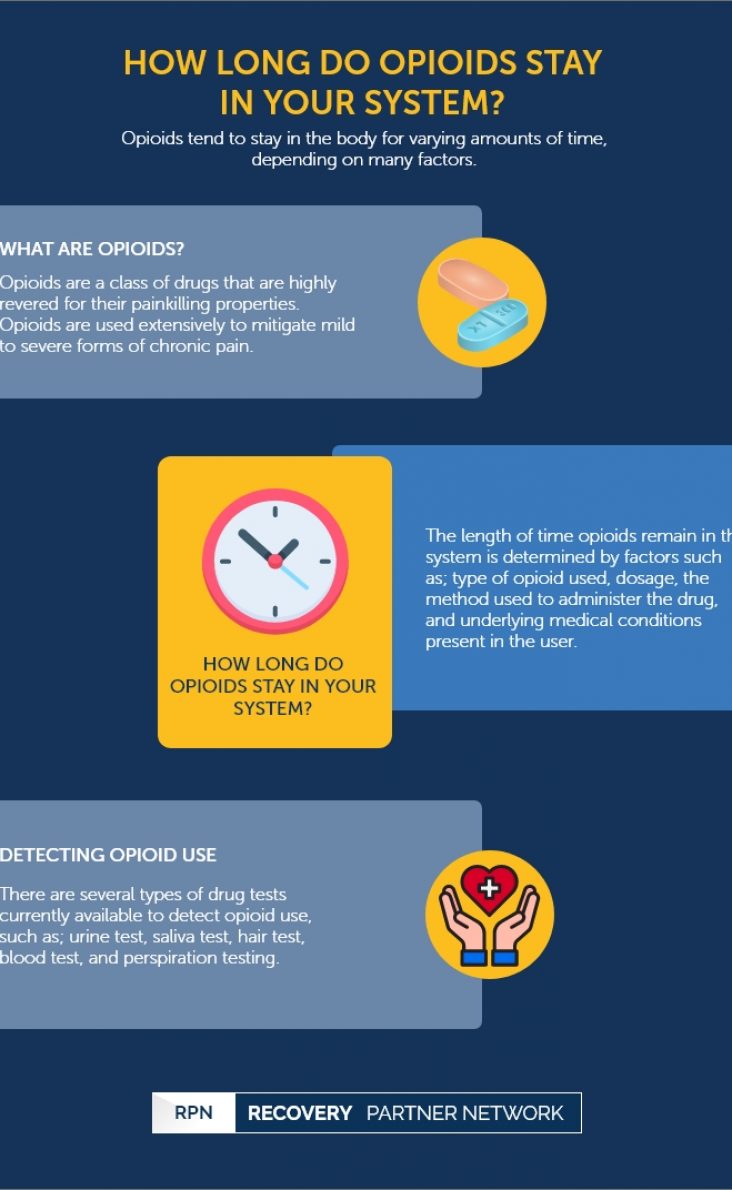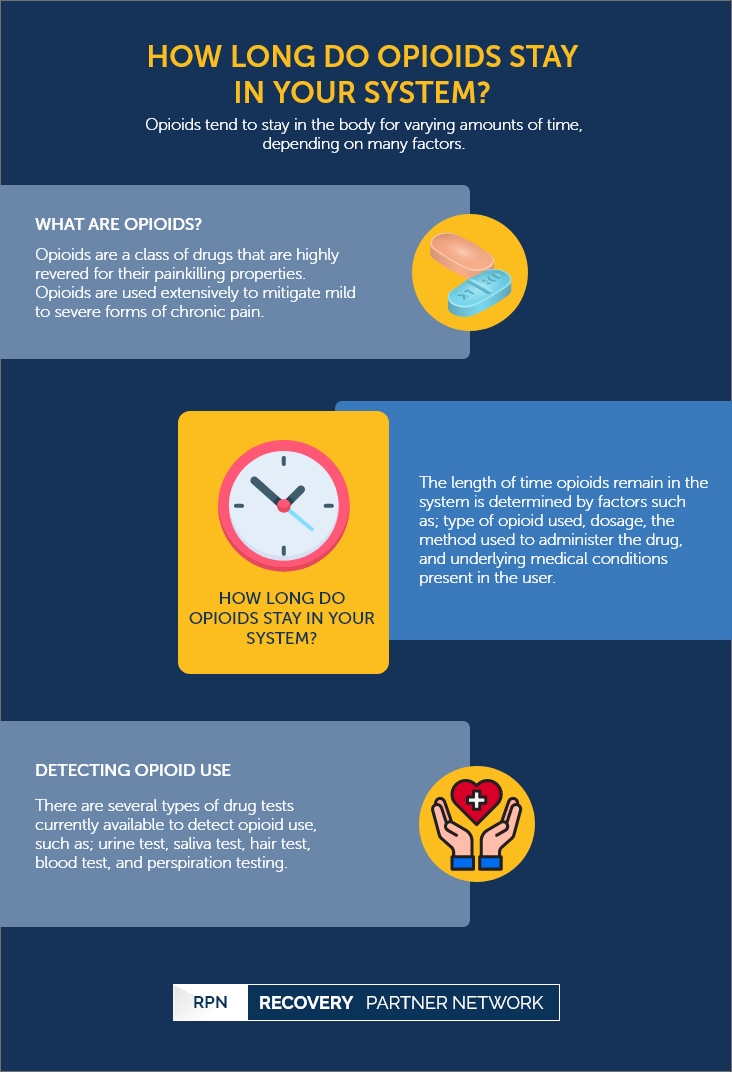Opioids tend to stay in the body for varying amounts of time, depending on many factors.
How Long do Opioids Stay in Your System?
Opioid
- Hydrocodone/paracetamol addiction
- Buprenorphine/Naloxone addiction
- Central nervous system depressant
- Codeine addiction
- Dextropropoxyphene addiction
- Fentanyl abuse
- Hydromorphone addiction
- How Long do Opioids Stay in Your System?
- Hydrocodone addiction
- Kava addiction and abuse
- Loperamide addiction
- Lortab addiction
- Medical prescription opioid
- Methadone addiction
- Morphine addiction
- Norco addiction
- NyQuil addiction
- Opioid use disorder
- OTC substance abuse
- Oxycodone addiction
- Oxycodone/paracetamol addiction
- Opioid epidemic
- Lean addiction
- Pethidine addiction
- Snorting Oxycodone
- Synthetic Opioids
- Tramadol addiction
How Long do Opioids Stay in Your System? | Table of Contents
What are Opioids?
Opioids are a class of drugs that are highly revered for their painkilling properties. Opioids are used extensively to mitigate mild to severe forms of chronic pain that are associated with cancer and surgery. Their effectiveness in treating chronic pain led to the rapid increase in opioid prescriptions in the 2000s. However, due to their highly addictive nature, compulsive use of opioids can form a crippling addiction and dependency.
Illegal drugs such as heroin and fentanyl also fall within the opioid category but are much more powerful than the prescription counterparts.
FAQ
The standard immunoassay testing is a fast, inexpensive, and the most preferred form of opioid drug testing available. This test screens individual’s urine for traces of morphine, codeine, and heroin. However, it does not detect other opioids such as hydrocodone, oxycodone, methadone, fentanyl, buprenorphine, and tramadol.
Opioid Effect Timespan
Almost all opioids react similarly to the body’s receptors, but the duration of time their effects remain active within the body can differ. In pharmacology, these durations are measured by eradicating half-life, which is the amount of time it takes your body to metabolize and dispose of half of the drug’s original dose. It generally takes around five half-lives to dispose of a drug from the body completely.
There are three main classifications of the opioid half-life:
- Long-acting – Oxycontin, methadone, and Butrans.
- Short-acting – codeine, morphine, and hydrocodone.
- Rapid-onset – intranasal fentanyl and sublingual fentanyl.
These are the classifications that are typically considered by healthcare professionals when prescribing opioids to patients. For instance, during chronic pain, long-acting opioids are the most effective for extended periods of time. Conversely, if the pain is breakthrough, then a combination of both long-acting and short-acting opioids may greatly assist in alleviating the pain.
How Long Do Opioids Stay in Your System?
The length of time opioids remain in the system is determined by several factors, such as:
- The specific opioid used
- The amounts of the opioid consumed
- The regularly consumed dose
- The method of administration
- The presence of other drugs in the body
- Weight, age, gender, and ethnicity of the user
- Metabolism speed and opioid usage history of the user
- The presence of any underlying medical conditions that affect drug disposal from the body, such as kidney problems or any other health problems
These factors greatly influence the window of time when detecting opioids through tests. However, certain general guidelines are available to understand how long opioids remain detectable in a body.
FAQ
- How long does codeine stay in your system?
- How long does fentanyl stay in your system?
- How long does oxycodone stay in your system?
The half-life of codeine is relatively short, but its metabolites do tend to stay in your system for much longer. Codeine is detectable through a urine test for up to 2 to 3 days, a blood test for up to 24 hours, and a saliva test for up to 1 to 4 days.
Fentanyl is a highly potent prescription opioid that is detectable in a urine test between 24 to 72 hours, hair test for up to 3 months, and blood test between 5 to 48 hours, depending on the dose used.
Oxycodone generally clears the blood within 24 hours but can be detectable through a urine test for up to 3 to 4 days and a saliva test for up to 4 days.
Detecting Opioid Use
Drug testing is a common procedure amongst many employers to ensure that the prospective employee will be a productive and reliable asset to the organization. Drug testing is also commonly used in workman’s compensation cases, parole, child custody disputes, sports, and in many other instances. Contrary to popular beliefs, all drug tests do not specifically sample urine or look for the same drugs. Instead, certain tests also sample blood, saliva, and hair to detect drug use from months before the test date.
Urine testing is by far the most popular and commonly used test for detecting drug use. When the body metabolizes different substances, the byproducts are usually filtered through the kidneys and into urine for final disposal. Since these byproducts can contain particles that are specific for certain drugs, urine tests study these particles to identify the drug.
Although this test is most often preferred for its less invasive nature, its window for accurately detecting drug use is narrower than urine tests. Drug presence may not be detected accurately through this test unless the drugs have been ingested within several hours before testing.
Similar to urine testing, this form of testing also depends on the body’s metabolic byproducts to detect drug presence. When the body metabolizes a drug, the metabolites can pass through the blood in the scalp and accumulate in growing hair. As such, your hair can operate as a month-long record log of the substances that were ingested. This test can also detect the presence of certain drugs, such as marijuana, months past the original drug use. Nevertheless, this test is less common as most workplaces are only interested in knowing the current or recent drug use of candidates.
Blood tests reveal reports of not just the recent drug use but also the levels of drugs in the blood at a particular time. This is the only test that guarantees a result during the test, while others usually require the assistance of specialized test facilities to verify results. Nevertheless, this test is comparatively quite expensive and invasive in nature. The costs and rigorousness associated with this test make it the least preferred by employers.
This is the latest and the least common drug test in the market. Since this test uses sweat as a sample, it can take around two weeks for completion as testing sweat can take longer. This test is mostly utilized to monitor individuals on probation rather than to test individuals for employment.
Recovery Partner Network
We aim to educate and empower. If you feel our library of resources does not cover your specific need, reach out to us, and we would be happy to help.
STATISTICS
© Copyright 2025


